Hiroshima & Itsukushima
- hm
- Sep 18, 2024
- 4 min read
Thinking about Japan, my mind always goes to the World War II bombing, and I visited Hiroshima and Nagasaki. I went again in the most recent trip and walked around the Peace Memorial Park.

On the towards the ground zero monument, I saw the 'A-bomb Victim' sculpture. It had a brief description of the bombing. The statue reminds us of the victims of the atomic bomb and the roof tiles melted by the heat rays. The ground just below the explosion reached 4,000 degrees centigrade and upwards till 1km, it was 1,800 degrees.
The Motoyasu river on whose bank is this and many other monuments, right next to the ground zero, was full of dead citizens after the blast. The roof tiles from the Motoyasu riverbed were collected by high school students after 1977 to make this monument.
The A-Bomb dome was a short distance away. The A-Bomb Dome is a mere skeleton of the former Hiroshima Prefectural Industrial Promotion Hall, built in 1915. It is the building closest to the point where the bomb was dropped. It has remained partially standing and was left unchanged after the bombing in memory of the casualties.
This dome is an officially designated memory for Japan's and humanity's collectively shared heritage of the catastrophe. The A-Bomb Dome was added to the UNESCO World Heritage List.

I walked around the structure to see it from different viewpoints. At 8:15AM on 8/6/1945, A B-29 bomber dropped the bomb that exploded 600 meters, near this building and instantly killing everyone in it.
As the city was rebuilt, people opinion was to preserve this dome as a reminder of the horrors of the war and the city adopted the charter to preserve it.
The explosion by a single bomb claimed the lives of over 200,000 people and the city area of about 2-km radius was turned into ashes. To remind further generations of this tragic fact and to make it a lesson for humankind, the reinforcement work of the ruins was done to preserve it forever.

A young boy and girl statue with the boy holding a dove symbolizing peace was on the grounds nearby.

The bust of Miekichi Suzuki, a children's stories author holding peace pigeons was next to the boy and girl statue.

The A-Bomb dome was visible clearly from the opposite bank of the Motoyasu river.
The Peace Memorial Park continues on the other side of the river. The bell of peace monument urges people to ring the bell to appeal for peace.

The surface of the bell is a map of the world with inscriptions in Greek, Japanese and Sanskrit. The Greek embassy donated the bell to the Peace Park and provided the Socrates quote "Know yourself" as the Greek inscription. The Sanskrit text is a quotation from Longer Sukhāvatīvyūha Sūtra.

I walked around the bell and rang it.
The Children's Peace Monument is next to the Bell of Peace.

It commemorates Sadako Sasaki and all the innocent children who died due to the atomic bombing. Sadako was 2 years old at the time of the bombing and she was exposed at home about 1.7 kilometers from hypocenter.
She had no apparent injuries soon after the bombing, she was suddenly hospitalized because of the leukemia 10 years later. After eight months in the hospital, she died surrounded by her family. In hospital, she continued to fold Orizuru (paper cranes) with her desire to get well. The story of Sadako and Orizuru has spread around the world and Orizuru is known as a symbol of peace.

A very recent statue of Gandhi was on the path, inaugurated by the current Indian Prime Minister.

I walked around the bustling, modern city of Hiroshima. It has good food, clean roads, efficient transportation. Unless you know of its history, you will not guess in its current state that it was rebuilt entirely after the war.

With the Japan Rail (JR) pass, I could take a trip to the nearby island of Miyajima.

Itsukushima is better known as Miyajima and is the site of a UNESCO world heritage site of the Itsukushima Shrine.

The boat ride takes less than half hour for the 10km or so distance.

The sacred peaks of Mount Misen, extensive forests, and the beautiful ocean view made for a very scenic journey.
The shrine best known for its "floating" Torii'. Soon the Tori was visible.

I got out of the ferry and walked in the hot sun for about half a mile on cobbled stone streets lined with food stores and ice-cream shops to arrive at the entrance to the shrine.

Passing through the large entrance guarded by two bid lions, I proceeded to the temple structure.

From the temple, in the Torri is visible in its full glory.

I walked around the path inside the temple and kept getting my attention stolen by the Tori.

The low tide meant that the surrounding areas of the temple were not flooded thereby revealing many tide pools with small snails, fish and crabs.

There were more lion statues on the perimeter.

The blue skies and good weather meant a lot of tourists were out.

I decided to find a way that led to the Tori.

To reach as close to the Tori as possible, I needed to wade through the water.

The closer I got the grander it looked.

I took pictures from various angles.
Then I walked by the tide pools.

On the other gate was the statue of Kiyomori, the 12th century leader of the Heian period of Japan. He promoted his grandson Antoku as the new emperor and established the Heishi Government. Kiyomori and his clan donated and helped remodel the shrine in 1168 ad.
I had enjoyed the visit to this shrine again, just as much as I did almost twenty years ago. With the temple's beauty, the forests. mountains and messages of peace from Hiroshima memorial, I continued on with happiness.








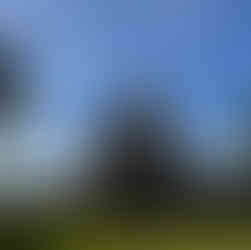


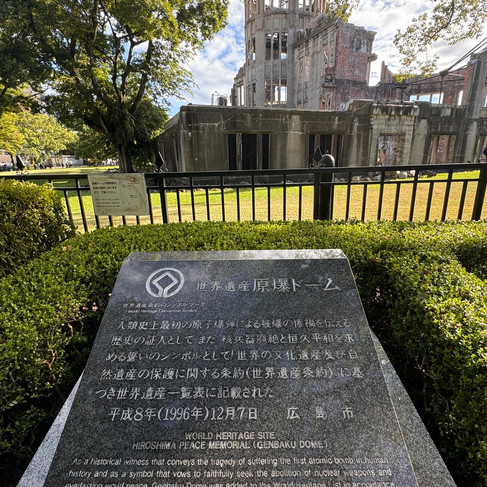



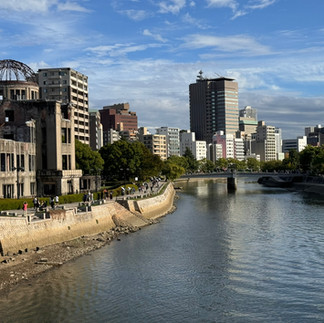




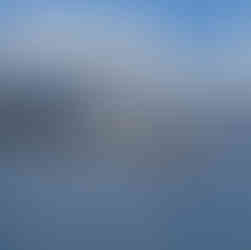


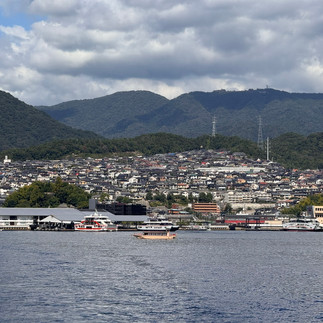



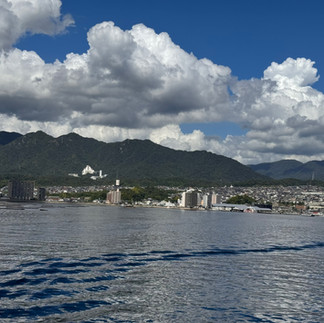




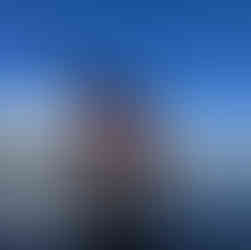





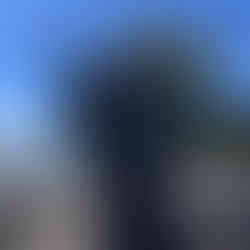

Comments